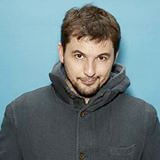Christian Tagliavini was born in 1971 in Switzerland, where he currently lives and works as a fine art photographer and craftsman. His work is heavily shaped by a childhood spent in Parma, where he grew up immersed in the rich artistic culture of the Plain of the Po, Italy’s longest river.
Tagliavini’s evocative images represent just the final stage in his artistic process. His photographs capture the creative vision in his mind’s eye, which he brings to life with handcrafted props, made-to-measure costumes and unconventional models. This behind-the-scenes work establishes him as an artisan- photographer.
Choosing unexplored concepts as themes, Tagliavini’s work narrates open-ended stories, inviting the viewer to actively experience unique ideas, sensations and feelings, and ultimately decide the ending for themselves.
A self-taught photographer, Tagliavini originally trained in architecture and worked as a graphic designer. His interest in photography was sparked in 2000, at a photographic exhibition in Milan. Fascinated by the technical aspects of photography, he tried his hand at several photographic disciplines before discovering that the mise-en-scène technique was the most effective way to capture the stories that lived in his imagination.
Embracing the art of slow photography, Tagliavini’s creative approach involves meticulous planning and careful design. Each project begins with initial historical and iconographic research, feasibility assessments, sketches, storyboarding, colour experimentation, and composition before he sets about making his vision a reality.
Tagliavini uses various techniques to handcraft each and every detail, including the props and backdrops. Each costume is fashioned to Christian’s detailed designs, including the fabric and colour choices, and is made-to-measure for each model.
Where possible, Tagliavini prefers to work with non-professional models, drawing inspiration from their spontaneity and curiosity. A champion of unconventional beauty, he has always favoured personality over a classical aesthetic. His models represent the only detail of his work that he cannot control: their expressiveness is instinctive and they often inspire him to take his stories in completely new directions. This unscripted detail casts him in the role of observer rather than director.
Christian Tagliavini won the Hasselblad Masters Fine Art Category in 2012 and the IPA Fine Art: Portrait prize in 2013. His work has been exhibited in many art galleries and museums worldwide.
Selected Books on

